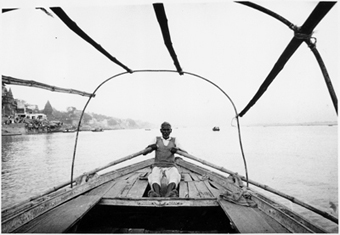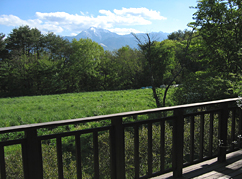 |
|
Here and There introduces art, artists, galleries and museums around Japan that non-Japanese readers and first-time visitors may find of particular interest. The writer claims no art expertise, just a subjective viewpoint acquired over many years' residence in Japan.
|
|
 |
|
|
 |
 |
Hitomi Watanabe's Asian Pilgrimage
Alan Gleason |
 |
 |
|
 |
From the series "Tenjiku" (an ancient Japanese name for India),
© Hitomi Watanabe |
|
From the series "Monkey Planet",
© Hitomi Watanabe |
|
Hitomi Watanabe launched her career in the most dramatic way imaginable -- as the only photographer to record Japan's campus uprisings from behind the barricades. Her gritty monochrome work from 1968 to 1969, when riot police stormed Tokyo University's student-occupied Yasuda Hall, is gaining renewed appreciation today.
But it is Watanabe's subsequent body of work, assembled over the course of a life's journey geographically and spiritually far removed from Japan's stormy sixties, that dominates the retrospective currently on view at the Philia Museum. Titled "Journey's Door," this selection of 100 photographs taken over the past four decades highlights three of her recurring themes: lotuses, monkeys, and India.
As the student movement sputtered to a halt in the early seventies, Watanabe left Japan on the first of several long sojourns through Southeast and South Asia, particularly India and Nepal. There she fell in love with the sublime chaos of the subcontinent, and her ardor imbues every portrait of the mendicants, boatmen, children, cows and monkeys she met there.
Since then she has focused increasingly on non-human denizens of this world -- notably monkeys and lotus flowers, subjects that reflect her deep affinity for Hindu and Buddhist mythology. Watanabe describes how she spent so much time with her simian subjects -- in India, Nepal, Bali, and the mountains of her homeland -- that they accepted her as one of their own and allowed her to photograph them close-up. The startling intelligence in these primates' eyes makes one ponder whether describing their expressions as "nearly human" is a compliment or an insult.
More recently Watanabe has ventured into the realm of color to shoot a stunning series on lotus flowers. In contrast to her recent color photos of India, where the color almost seems extraneous -- a distraction from the power of the content itself -- these glorious images are an example of color photography at its most relevant.
Watanabe's rich and varied oeuvre is brought together under one roof -- for the first time, surprisingly -- by the Philia Museum, opened in 1990 by the Nakayama family of Kobuchizawa in the Yatsugatake highlands, a pastoral setting two hours west of Tokyo. Mr. Nakayama, a local farmer and an art aficionado, named his museum after the Greek word for brotherly love and built it to resemble a country church sanctuary, modest in dimensions but with vaulted ceilings, high windows, and a full-sized pipe organ. The Nakayama collection includes a heart-rending series of drawings made by the Polish painter Mieczyslaw Kosceilniak while he was imprisoned at Auschwitz.
The Philia is truly a family operation: while Mr. Nakayama continues to farm, his wife Taeko serves as director of the museum and their daughter Shiho as curator. Coupled with the postcard-perfect view of Japan's Southern Alps from the veranda running the length of the building, this charming and contemplative space proves an ideal backdrop for Watanabe's spiritually and sensually lush work, which will be on display there until July 5, 2009.
 |
|
 |
| From the series "Lotus", © Hitomi Watanabe |
|
View of Mt. Komagatake from the veranda of the Philia Museum.
All images courtesy of the Philia Museum
|
|
|
|
|
 |
|
 |
|
 |
Hitomi Watanabe: Journey's Door |
 |
|
 |
25 April - 5 July 2009 |
|
Philia Museum |
|
3476-76 Kami-Sasao, Kobuchizawa-cho, Hokuto-shi, Yamanashi Prefecture
Phone: 0551-36-4221
Open 9:30-5:00 (July-September till 6:00), closed Wednesdays
Transportation: 20 minutes walk or 5 minutes by taxi
from Kobuchizawa Station on the JR Chuo Line |
 |
|
|
 |
 |
Alan Gleason
Alan Gleason is a translator, editor and writer based in Tokyo, where he has lived for 25 years. In addition to writing about the Japanese art scene he has edited and translated works on Japanese theater (from kabuki to the avant-garde) and music (both traditional and contemporary). |
|
|
|
 |
 |
|